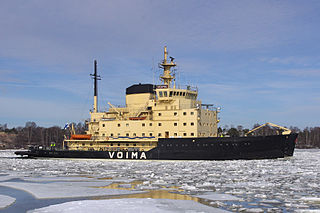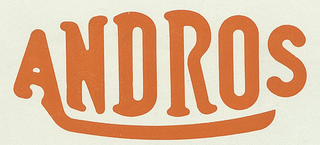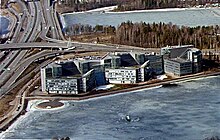
The Finnish Navy is one of the branches of the Finnish Defence Forces. The navy employs 2,300 people and about 4,300 conscripts are trained each year. Finnish Navy vessels are given the ship prefix "FNS", short for "Finnish Navy ship", but this is not used in Finnish language contexts. The Finnish Navy also includes coastal forces and coastal artillery.

Ilmarinen was a Finnish Navy Panssarilaiva, Swedish Pansarskepp. The unit was constructed at the Crichton-Vulcan shipyard in Turku, Finland, and named after the mythological hero Ilmarinen from the Finnish national epic, the Kalevala. Ilmarinen was the flagship of the Navy from 1 May 1933 until her sinking on 13 September 1941.

Suomen Joutsen is a steel-hulled full-rigged ship with three square rigged masts. Built in 1902 by Chantiers de Penhoët in St. Nazaire, France, as Laënnec, the ship served two French owners before she was sold to German interest in 1922 and renamed Oldenburg. In 1930, she was acquired by the Government of Finland, refitted to serve as a school ship for the Finnish Navy and given her current name. Suomen Joutsen made eight long international voyages before the Second World War and later served in various support and supply roles during the war. From 1961 on she served as a stationary seamen's school for the Finnish Merchant Navy. In 1991, Suomen Joutsen was donated to the city of Turku and became a museum ship moored next to Forum Marinum.

Katanpää-class mine countermeasure vessels are a class of three multipurpose mine countermeasure vessels (MCMV) ordered by the Finnish Navy. The nearly 250 million euro contract was awarded to the Italian shipyard Intermarine S.p.A. in 2006. Initially, all three vessels were scheduled to be delivered by 2014 and the class was expected to achieve operational readiness by 2015, but there have been various delays and the last vessel was handed over to the Finnish Navy in November 2016.

The Nuoli-class motor gunboats was a series of thirteen fast attack craft of the Finnish Navy. The ships were constructed in 1961 by Oy Laivateollisuus Ab in Turku, and modernized in 1979. The Nuoli motor gunboats played a very important role in naval training and were in service until the early 90s.

Keihässalmi was a minelayer of the Finnish Navy. She was commissioned in 1957 and remained in service until 1994, after which she was turned into a museum ship in Turku. The vessel was named after the strait of Keihässalmi, which is located in Sipoo. Keihässalmi was the first Finnish minelayer to be constructed after World War II.

The Ukrainian patrol vessel Sloviansk (P190) was an Island-class patrol boat of the Naval Forces of the Armed Forces of Ukraine. Originally named USCGC Cushing when in service with the United States Coast Guard, the vessel was acquired by Ukraine in 2018 and arrived in Ukraine on 21 October 2019. Sloviansk was sunk in combat on 3 March 2022 by a Russian air-to-surface missile.
Turku Coastal Regiment was a Finnish coastal artillery unit operating in the Turku area and Archipelago Sea. It was formed on 10.9.1939 as Turku Sector as part of the neutrality guard and later Winter War coastal sector system from a peace time 1st Independent Coastal Artillery Battalion. Turku Coastal Regiment was disbanded as an independent unit on 30.6.1998 and became part of the newly formed Archipelago Sea Naval Command as Turku Coastal Artillery Battalion.
Herakles was a pusher vessel owned by Finnish towing and marine salvage company Alfons Håkans Oy Ab. The ship, originally built as salvage tug Into in 1967, was converted to a pusher in 1991 to be chartered to Rautaruukki Oyj and later ESL Shipping Ltd as the third pusher vessel for the Finnpusku system, a Finnish integrated tug and barge system built in the mid-80s.

Fabian Wrede class consists of three training ships used by Finnish Navy. The ships are used by the Naval academy of Finland for basic seamanship training, with particular emphasis on navigation in coastal and archipelago waters. The vessels in the class are Fabian Wrede, Wilhelm Carpelan and Axel von Fersen. All ships were built by Uudenkaupungin työvene Oy and commissioned between 2006 and 2008. The ships will replace the old Heikki class training ships.

Apu was a Finnish state-owned steam-powered icebreaker built by Howaldtswerke in Kiel, Germany, in 1899. Initially owned by a private shipping company founded by shipowners from the Finnish city of Turku and known as Avance, she was later purchased by the Finnish Board of Navigation and her name was translated into Finnish. Apu remained in service until 1959, when she was replaced by the new diesel-electric Murtaja.

Voima is a Finnish state-owned icebreaker. Built by Wärtsilä Hietalahti shipyard in Helsinki in 1954, she was the first icebreaker in the world to be equipped with two bow propellers and generated widespread publicity that helped the Finnish shipbuilding industry to become the world leader in icebreaker design.

Turva is a Finnish offshore patrol vessel. Built in 2014 by STX Finland Rauma shipyard for the Finnish Border Guard, she is the largest vessel of the fleet as well as the first patrol vessel in Finland powered by liquefied natural gas (LNG).

Oy Andrée & Rosenqvist Ab was a boat building yard and engineering works in Turku, Finland in 1906–1939. The company was known for its fast and high-quality boats and also marine engines, which were also applied in stationary use.

Forum Marinum is maritime museum located in Turku, Finland.

Polaris is a Finnish icebreaker. Built in 2016 by Arctech Helsinki Shipyard, she is the most powerful icebreaker ever to fly the Finnish flag and the first icebreaker in the world to feature environmentally friendly dual-fuel engines capable of using both low-sulfur marine diesel oil (LSMDO) and liquefied natural gas (LNG). Polaris was initially ordered by the Finnish Transport Agency, but the ownership was transferred to the state-owned icebreaker operator Arctia after delivery.
Meyer Turku Oy is a Finnish shipbuilding company located in Turku, Finland Proper. The company is fully owned by German shipbuilder Meyer Werft GmbH. The main products are cruise ships and cruiseferries.

MS Sea Wind is a Ro-Ro and passenger ship, which operated on the Vuosaari–Muuga route. The ship was built in 1972 Helsingørs Skipsværft dock in Helsingør. The vessel is registered under the Liberian flag.
Oy Laivateollisuus Ab (LaTe) was a Finnish shipbuilding company located in Pansio, Turku. The company was founded in 1945 to serve Finnish war reparation industry and focused on wooden ships. The first vessels were a series of schooners, which were followed by other wooden vessels. The last wooden hulls were produced in 1958. The company continued producing wooden gluelam structures in parallel with shipbuilding.
















